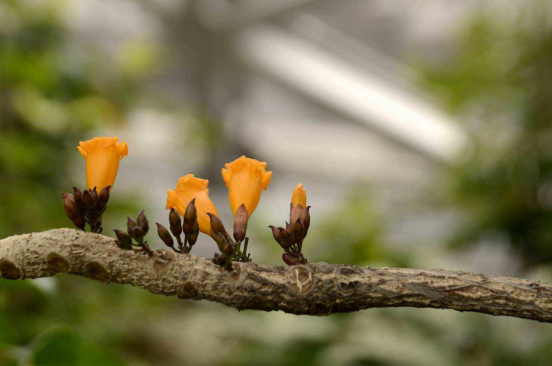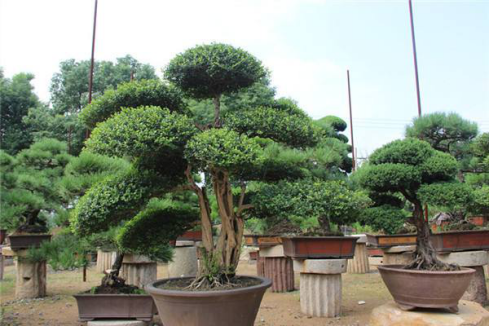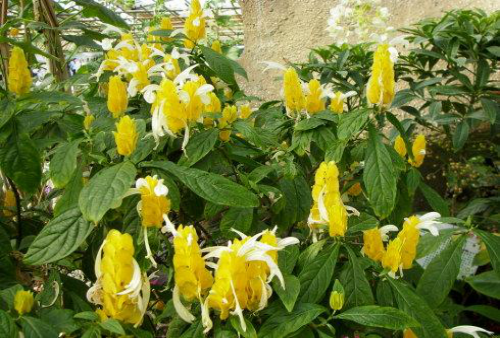Matters needing attention in the Culture of Burning Flowers
1. Common diseases
Rhizoctonia solani is the main disease of burning flowers, which mainly occurs when it is rainy in spring. No matter the mature fire flower or the fire flower seedling will be affected by the disease, the main performance is that there will be dark brown spots in the affected area, and even a large area of death will occur in serious cases. We should have the following countermeasures to deal with this.
① removes burned plants in time to prevent the disease from spreading to other plants.
② selects plants that have not been affected by diseases for transplanting, and the soil must also be disinfected without germs, and must be fertilized with rotten fertilizer after planting.
The disinfection of ③ soil is the key point. It is recommended that 50 milliliters of formaldehyde and 6 kilograms of water be used for disinfection per square meter of soil, or pentachloronitrophenol and fine sand can be mixed in proportion and sprinkled on the nursery bed to cultivate fire and burning flowers, so that the disease can be prevented from the source.
④ sprays 70% methyl topiramate 1000 times or 75% chlorothalonil 1000 times every 10 days in the spring to strangle the disease in the cradle.

Second, common insect pests
The main pests of burning flowers are aphids, ulnar moths, ground tigers and beetles. Aphids cause coal fouling; the larvae of Spodoptera litura eat young leaves; and the larvae of ground tigers and beetles eat the roots.
Control aphids can be sprayed with 5% diesel emulsion or Baume three to five stone sulfur mixture before sprouting in order to kill overwintering adults and eggs. Spray the medicine again after falling flowers, and spray it for the third time in October in autumn. Attention should be paid to the control of the larvae of Spodoptera litura, which can be sprayed with 1500 times of methamidophos. The larvae of ground tiger and beetle are underground pests. The control method is to strengthen the management of nursery and not to apply immature organic fertilizer. Ploughing in winter, the overwintering larvae turn to the surface to freeze to death.
The above are the cultivation methods of burning flowers arranged by Xiaobian and the countermeasures for the prevention and control of major diseases and insect pests. I hope it will be helpful for you to raise burning flowers in the future. Thank you for your reading.
Propagation methods of Burning Flowers Culture methods and matters needing attention of burning flowers
Bonsai Flower Network Guide: today, the editor of Flower Bonsai Network shares with you the breeding methods of burning flowers, the breeding methods of burning flowers and matters needing attention. Let's take a look.
The fire flower is a kind of small tree, the fire flower is orange, very bright, the blossom is like the flame burning, very vivid, today we come to understand the propagation method of the fire flower.
Sowing and propagation of burning flowers
Sowing and reproduction is the main way of propagation of burning flowers.
Burning flowers can blossom in many seasons, so we can collect seeds in many seasons, so we usually use the way of sowing and reproduction to reproduce burning flowers. The way we collect the seeds of burning flowers is to pick the ripe fruits of burning flowers, dry them in a windless environment, and gently knock down the seeds of burning flowers after they crack in the air, so that we can collect the seeds of burning flowers. We can store the seeds of burning flowers for the winter and sow the seeds at the right time.
We usually sow seeds in warmer spring, because the seeds of burning flowers are very small, so we usually sow them directly on the soil, then cover them with a thin layer of soil to maintain a temperature of about 25 °C. and at the same time keep the soil moist, it takes a week or so to sprout and plant three to five years to blossom.
Cutting Propagation of Burning Flowers
Generally speaking, the method of cutting propagation will not be used in the propagation of fire flowers, because the survival rate of fire flowers propagated by this method is relatively low. in order to improve the survival rate of cutting propagation, we can use the method of vegetative propagation. the method of high-altitude pressing can effectively improve the survival rate of cuttage propagation, and the fire flowers propagated by this method are generally used in potted plants.
Fire flowers successfully propagated by this method usually blossom in a year or two.
Culture methods and points for attention of Burning Flowers
Burning flower is a kind of woody plant, which is strong in nature and easy to breed. It is also full of artistic conception to use burning flowers as ornamental trees and to watch their gorgeous flowers.
The culture method of burning flowers soil
Huo Chaohua likes the soil with deep and fertile soil, and the neutral or slightly acidic soil with good drainage is better, which can tolerate barren and needs to apply a certain amount of base fertilizer when planting.
Light and temperature
Burning flowers like the light and the warm growing environment. Burning flowers can be heat-resistant but not cold-resistant. The suitable temperature for growth is between 23 ℃ and 30 ℃. It can withstand high temperature of about 0 ℃ in winter, but it can not be kept at low temperature for a long time, which will make the plant frostbite. Generally, fire-burning flowers are cultivated in China, which can be planted in open field in South China, and potted plants are needed in other areas in winter and moved into indoor conservation. Burning flowers like the sunny growth environment, there is sufficient light will grow well, but can also withstand semi-shade.
Watering and fertilizing
The demand for water and fertilizer for burning flowers is not high, so it is necessary to pay attention to replenishing water in time during the growth period, especially in times of high temperature and drought. Fertilization needs to be carried out according to the fertility of the soil, and appropriate supplementary fertilizers are needed during the growing period, mainly thin fertilizer, fertilizing 3-5 times a year, more nitrogen fertilizer can be applied, and phosphorus and potassium fertilizer should be increased in autumn.
Matters needing attention in the Culture of Burning Flowers
Propagation of fire and burning flowers is commonly used by cutting, sowing or striping, all of which can be carried out in spring.
Common diseases and insect pests
The common disease of burning flowers is blight, which mainly occurs when it is rainy in spring and suffers greatly. Insect pests are mainly aphids, Spodoptera litura, large and small ground tigers and beetles, and so on. These pests will more or less harm the burning flowers and need to be controlled in time.
Pruning
Burnt flowers are more pruning-resistant plants, which can be pruned frequently to maintain their plant type.
Culture methods and points for attention of Burning Flowers
The culture method of burning flowers soil
Huo Chaohua likes the soil with deep and fertile soil, and the neutral or slightly acidic soil with good drainage is better, which can tolerate barren and needs to apply a certain amount of base fertilizer when planting.
Light and temperature
Burning flowers like the light and the warm growing environment. Burning flowers can be heat-resistant but not cold-resistant. The suitable temperature for growth is between 23 ℃ and 30 ℃. It can withstand high temperature of about 0 ℃ in winter, but it can not be kept at low temperature for a long time, which will make the plant frostbite. Generally, fire-burning flowers are cultivated in China, which can be planted in open field in South China, and potted plants are needed in other areas in winter and moved into indoor conservation. Burning flowers like the sunny growth environment, there is sufficient light will grow well, but can also withstand semi-shade.
Watering and fertilizing
The demand for water and fertilizer for burning flowers is not high, so it is necessary to pay attention to replenishing water in time during the growth period, especially in times of high temperature and drought. Fertilization needs to be carried out according to the fertility of the soil, and appropriate supplementary fertilizers are needed during the growing period, mainly thin fertilizer, fertilizing 3-5 times a year, more nitrogen fertilizer can be applied, and phosphorus and potassium fertilizer should be increased in autumn.
Matters needing attention in the Culture of Burning Flowers
Propagation of fire and burning flowers is commonly used by cutting, sowing or striping, all of which can be carried out in spring.
Common diseases and insect pests
The common disease of burning flowers is blight, which mainly occurs when it is rainy in spring and suffers greatly. Insect pests are mainly aphids, Spodoptera litura, large and small ground tigers and beetles, and so on. These pests will more or less harm the burning flowers and need to be controlled in time.
Pruning
Burnt flowers are more pruning-resistant plants, which can be pruned frequently to maintain their plant type.
- Prev

Cutting Propagation of potted Holly
Holly is mainly propagated by cuttings. Cutting propagation is simple and easy to work, rooting quickly, and the survival rate is also high, so it is widely used in production. Nursery bed selection of cutting seedbed should choose the place with high topography, deep soil layer, loose soil and good drainage and irrigation. Cutting selection of holly can be carried out all the year round.
- Next

Method for breeding golden bract flower
Cuttage time is best in April, this time the most likely to survive, from the old branches take about 8-10 cm long tender shoots, cut in the sand, pay special attention to temperature and humidity to maintain the temperature above 21℃, humidity about 80%, about half a month can take root. all right
Related
- Fuxing push coffee new agricultural production and marketing class: lack of small-scale processing plants
- Jujube rice field leisure farm deep ploughing Yilan for five years to create a space for organic food and play
- Nongyu Farm-A trial of organic papaya for brave women with advanced technology
- Four points for attention in the prevention and control of diseases and insect pests of edible fungi
- How to add nutrient solution to Edible Fungi
- Is there any good way to control edible fungus mites?
- Open Inoculation Technology of Edible Fungi
- Is there any clever way to use fertilizer for edible fungus in winter?
- What agents are used to kill the pathogens of edible fungi in the mushroom shed?
- Rapid drying of Edible Fungi

